

Children have the unenviable combination of being both endlessly energetic and hilariously clumsy, which can often lead to accidents where their teeth pay the price. They are also not exactly known for their fantastic brushing habits, which can result in severe toothaches that need to be addressed right away. If your child is ever in need of immediate dental care, know that our emergency dentist offers trusted care right when you need it. We want to help make your kiddo feel better and help ease your mind because we understand that these situations can be very scary! So don’t hesitate to give us a call.
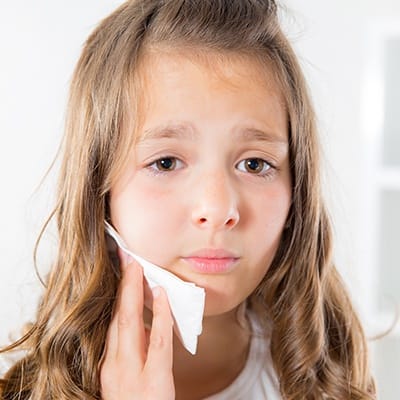
At our office, we’re available to help when you need us most. Here’s what you can expect during a dental emergency:
It can be tough to stay calm when your child is in pain, but if it concerns their teeth, know that the best thing you can do is give our dental office a call. Our team will walk you through first-aid tips over the phone and schedule an appointment so they can be seen right away. If your child is experiencing any of the following, don’t hesitate to give us a call!
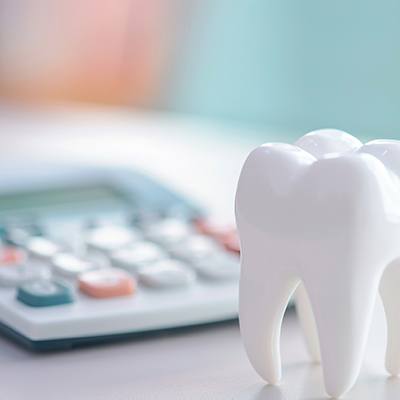
If your child has an unexpected dental emergency, getting them the right help quickly can help protect and preserve their still-developing smile. However, many parents worry that they won’t be able to afford the treatments needed to address the problem.
It’s natural to question how much your child’s dental emergency will cost, and our team will gladly provide a detailed estimate after we’ve had a chance to examine their condition. Continue reading to learn more about what to expect, and feel free to contact us for additional information!
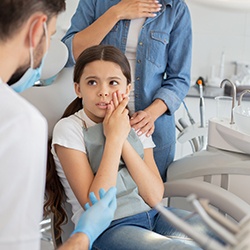
Once you and your child arrive at our office, our team will evaluate their teeth and gums to identify the underlying issue. Some concerns, like toothaches or gingivitis, can be relatively easily addressed with simple solutions, like a prescription mouthwash and instructions to improve your kid’s at-home dental hygiene routine.
However, other more severe concerns might require complex treatments, like a root canal to alleviate a toothache or infection, or placing a dental crown to protect injured teeth. We’ll recommend appropriate procedures and walk you through the details, including the pricing, for your approval before proceeding.

Most dental insurance policies cover a portion of pediatric dental emergencies, but you’ll likely still have some out-of-pocket expenses. This is because these plans are typically designed to promote preventive care, so they include basic services like exams and imaging, but usually only cover 50% to 80% of treatments needed to address problems, like root canals and dental crowns.
Please let us know if you’re unsure what your insurance includes and are having challenges finding the information. Our friendly office staff are familiar with different plans and can assist with claims, paperwork, or applications to help you maximize your benefits.

It’s natural to want the best possible care to address your child’s dental emergency, and we don’t want your finances to interfere with potentially smile-saving services. As a result, we offer the following options to help make your kid’s visit more affordable:
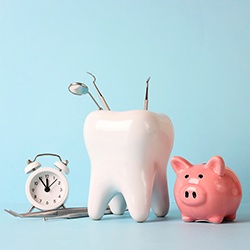
While some children experience unavoidable circumstances that lead to their dental emergencies, many urgent scenarios can be avoided. Caring for your little one’s teeth and gums consistently helps strengthen them so they’re less vulnerable to common oral issues, like cavities, gum disease, and injuries.
For instance, brushing and flossing twice daily removes plaque and bacteria that can harm their enamel and connective tissues. Also, regular visits with our providers every six months allow them to monitor your child’s dental health so they can catch and address any areas of concern, like swollen gums or cavities, before they cause an emergency.

Even with all the baby gates, safety locks, and other measures you put into place each day, children are likely to experience some falls and bumps despite our best efforts. However, there are certain precautions you can take that will dramatically lower your little one’s risk of a dental emergency! Below, you’ll find some of the easiest and most effective ways to help keep your child’s smile safe on a daily basis.

Depending on the age of your child, their manual dexterity when it comes to brushing and flossing their teeth is often in need of improvement. This is because they have yet to reach the age in which they are mature and able enough to clean the hard-to-reach areas, such as their molars, properly and effectively. As a result, their teeth can become prone to dental caries (cavities) and tooth decay. This is why, as parents, it is important that you start incorporating good oral habits at an early age. Nighttime brushing is especially important to make sure that their teeth don’t have any residual food that can contribute to the development of dental decay during that nightly 8-12 hours of sleep. Whether it is helping them brush and floss their teeth or supervising them during their morning and nighttime routines, making sure they are properly caring for their smile is crucial.
During their stages of development, children will go through phases which require different approaches to motivating or exciting them about brushing and flossing.

The typical kid loves candy of all types, but hard candies such as lollipops can be especially harmful if they bite or chew them. While they may taste good, these candies can lead to chipped, broken teeth and a trip to see their emergency pediatric dentist. If you want their teeth to remain fully intact, it is best to minimize these types of treats, instruct them not bite or chew the hard candies, and watch your little one closely when they’re enjoying them so as to prevent potential damage. Also, never allow your child to chew on ice or inanimate objects. Teeth with existing fillings, restorations, or decay can be especially prone to fracture due to a frequent ice-chewing habit due to the hard forces and contraction of the tooth surface due to the temperature change caused by the ice. Their pearly whites are not meant to sustain this type of pressure, resulting in fractures and more serious damage to their primary teeth.
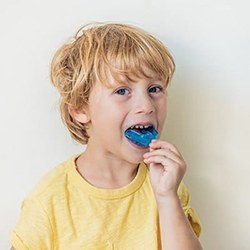
If your son or daughter enjoys playing sports, give yourself greater peace of mind by making sure they are wearing a mouthguard before they take to the court or field. Both multiplayer contact sports, as well as solo activities like biking or gymnastics, can wreak havoc on a child’s smile. Whether it is a hard-hitting tackle that results in a knocked-out tooth or a sudden fall off the balance beam that causes a busted lip and shifted tooth, a mouthguard can minimize the impact and keep their teeth and soft oral tissues from serious injury.
But mouthguards are not only for sports. They are also beneficial if your little one is prone to bruxism (teeth grinding/clenching). Mouthguards can also be utilized to address issues of sleep disordered breathing, early dental crowding, and growth and development issues during early stages of dentition. By talking to Dr. Justin or Dr. Sage about having a custom-made mouthguard created for your child, their teeth and jaw will be better protected while they sleep, alleviating any potential pain or wear and tear.

If you ever notice that your child is trying to open a package or container with their teeth, stop them immediately. This tip is not only important for children but also for adults. Teeth are designed to chew and tear through food, not objects. We’ve seen and dealt with emergencies from children opening anything from yogurt pouches to removing bottle caps with their teeth. Try your best to discourage these habits. Instead, make sure you can jump into action and use scissors or another appropriate tool to open the item for your child.

As a parent, you know how important it is to protect your children from possible dental emergencies. Unfortunately, falling off a bike, taking a fly ball to the mouth, or even tripping while running can lead to a soft tissue laceration, knocked-out tooth, or a chipped or cracked tooth. No matter the injury, it’s important you feel confident taking care of the problem while at home. At our office, we know you probably have a lot of questions about emergency dentistry for kids, which is why we’ve compiled a list of frequently asked questions for you to review. Should you have additional questions, we encourage you to contact our office for assistance.
At our office, Dr. Justin and Dr. Sage are pleased to offer sedation dentistry for children who experience dental anxiety or who need a more complex treatment or procedure. All sedation options are tailored to every patient. Whether it is nitrous oxide, oral conscious sedation, or general anesthesia we will make sure your child is safe and comfortable when dealing with a dental emergency.
Most commonly, children with minor dental anxiety may receive nitrous oxide sedation, whereas, moderate-to-severe dental phobia or an involved procedure usually requires oral conscious sedation. Only in instances where a child has extreme dental anxiety, special needs, or is undergoing a complex dental procedure will we use general anesthesia.
Dr. Justin and Dr. Sage are both experienced and board-certified pediatric dentists who can treat all types of smiles. If your child is experiencing a dental emergency, this can cause them to become more frantic and uneasy when arriving at our office. No matter what type of special needs your child may have, it is our job to create a warm and welcoming environment so that your child is comfortable. With advanced training to help special needs children, Dr. Justin and Dr. Sage can provide your child with the care they need, especially when they need it most.
While it is natural to think that the emergency room is the appropriate place to take your child should an injury occur to their mouth, there are only three reasons you should consider the ER over your child’s dentist’s office:
If your child is dealing with persistent sensitivity, pressure, or pain stemming from one of their teeth, you’ll be happy to know that there are several steps you can take to alleviate their symptoms in the short term. The first is steering clear of sugary, acidic, and spicy foods, including hard pretzels, ice cream, and lollipops. The second is placing a cold compress against the outside of their cheek for 10 minutes at a time (this will provide a temporary numbing sensation and alleviate inflammation). If their discomfort persists, then you can also give them an OTC pain reliever for kids, making sure to follow the directions on the label, of course.
Oftentimes, minor chips don’t result in any pain or discomfort. That said, we still recommend scheduling an appointment with one of our pediatric dentists. That way, they can complete a comprehensive oral exam and determine if the tooth is at risk of developing an infection or breaking further. If that’s the case, then Dr. Justin or Dr. Sage will let you know before providing the necessary restorative care.
Although baby teeth aren’t meant to last forever, there are several problems that can arise if they fall out too soon. So, if one of your child’s primary teeth gets knocked out while they are playing on the playground or participating in a sport, don’t wait – call us ASAP. The sooner you do, the sooner we can schedule a visit at our dental office, alleviate any pain your child is experiencing, and restore their healthy, happy smile.
If your child has something stuck between their teeth, you might think of reaching for something sharp to dislodge it, like a toothpick. Unfortunately, the wooden ones are not particularly safe to use since they can splinter and break off inside their mouth.
The good news is that there’s another easy way to remove the debris. First, dissolve some salt in warm water and have your child rinse with the mixture several times. Then, use a strand of floss to gently clean between their teeth. If that doesn’t do the trick, give us a call so we can provide further assistance.
Chronic bad breath can occur for several reasons. For many children, it’s inconsistent dental care. So, start by reinforcing healthy habits, like brushing for two full minutes each morning and evening as well as flossing every night before bed. If the odor persists, then don’t hesitate to schedule an exam with us. That way, one of our talented and experienced pediatric dentists can determine if an untreated oral health problem is the culprit.
Dentistry for Infants Dentistry for Toddlers Dentistry for Children Dentistry for Teens Sedation Dentistry Special Needs Dentistry See Our Pediatric Services